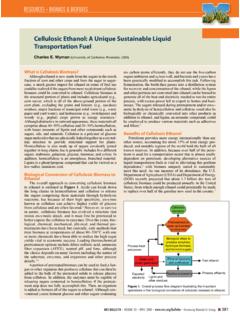Transcription of 5. Biomass Conversion Technologies
1 Biomass Conversion Technologies 5. Biomass Conversion Technologies Bioenergy consists of solid, liquid, or gaseous fuels. Liquid fuels can be used directly in the existing road, railroad, and aviation transportation Various Technologies exist to convert network stock, as well as in engine and turbine Biomass resources into power, heat, and fuels for use in UEMOA. electrical power generators. Solid and gaseous countries. fuels can be used for the production of electrical power from purpose-designed direct or indirect Several Technologies for converting turbine-equipped power plants. Chemical bioenergy are commercial today products can also be obtained from all organic while others are being piloted or in research and development. matter produced. Additionally power and chemicals can come from the use of plant-derived As new Technologies and processes industrial, commercial, or urban wastes, or develop, the UEMOA needs to agricultural or forestry residues.
2 Monitor progress to determine potential applications for Biomass Biomass resources include primary, secondary, expansion. and tertiary sources of Biomass . Primary Biomass resources are produced directly by photosynthesis and are taken directly from the land. They include perennial short-rotation woody crops and herbaceous crops, the seeds of oil crops, and residues resulting from the harvesting of agricultural crops and forest trees ( , wheat straw, corn stover, and the tops, limbs, and bark from trees). Secondary Biomass resources result from the processing of primary Biomass resources either physically ( , the production of sawdust in mills), chemically ( , black liquor from pulping processes), or biologically ( , manure production by animals). Tertiary Biomass resources are post-consumer residue streams including animal fats and greases, used vegetable oils, packaging wastes, and construction and demolition debris.
3 There are various Conversion Technologies that can convert Biomass resources into power, heat, and fuels for potential use in UEMOA countries. Figure 5-1 summarizes the various bioenergy Conversion processes. Biomass for Power and Heat 6. Combustion Biomass power Technologies convert renewable Biomass fuels to heat and electricity using processes similar to those employed with fossil fuels. At present, the primary approach for generating electricity from Biomass is combustion direct-firing. Combustion systems for electricity and heat production are similar to most fossil-fuel fired power plants. The Biomass fuel is burned in a boiler to produce high-pressure steam. This steam is introduced into a steam turbine, where 6. ESMAP, 2005. 45. Sustainable Bioenergy Development in UEMOA Member Countries Figure 5-1: Biomass Energy Conversion Overview Oil crops (rape, Sugar and starch plants Wet Biomass (organic Solid Biomass ) (sugar-beet, cereals, etc.))
4 Waste, manure, etc.). refining crushing extraction hydrolysis pyrolysis gasification fermentation anaerobic Vegetable oil Sugar Pyrolytic oil Fuel gas Biogas hydrolysis transesterification fermentation combustion Methyl ester Ethanol (biodiesel). ETBE. Liquid biofuels Electricity Heat Vapor cogeneration Transport process Electric devices Heating Source: Renewable Energy World, 2006. 46. Biomass Conversion Technologies it flows over a series of turbine blades, causing the turbine to rotate. The turbine is connected to an electric generator. The steam flows over and turns the turbine. The electric generator rotates, producing electricity. This is a widely available, commercial technology. Combustion boilers are available in different designs, depending on application and Biomass characteristics. The main options are to burn the Biomass on a grate (fixed or moving), or to fluidize the Biomass with air or some other medium to provide even and complete burning.
5 Steam turbine designs also vary in terms of their application. To maximize power production, condensing turbines are used to cool steam. Combined Heat and Power Most Biomass -fired steam turbine plants are located at industrial sites that have a steady supply of Biomass available. These include factories that make sugar and/or ethanol from sugarcane at pulp and paper mills. At these sites, waste heat from the steam turbine can be recovered and used for meeting industrial heat needs further enhancing the economic attractiveness of such plants. Referred to as combined heat and power (CHP) facilities (also called cogeneration facilities), these facilities are highly resource efficient and they provide increased levels of energy services per unit of Biomass consumed compared to facilities that generate power only. Conventional thermoelectric stations convert only about one-third of the fuel energy into electricity.
6 The rest is lost as heat. The adverse effect on the environment through wasteful use of power particularly detrimental in light of rising fuel costs means that the efficiency of thermoelectric stations must be increased. CHP provides more efficient production of electricity, where more than four-fifths of the fuel's energy is converted into usable energy, resulting in both economic and environmental benefits. Cogeneration is the consecutive (simultaneous). production and exploitation of two energy sources, electrical (or mechanical) and thermal, from a system utilizing the same fuel. CHP could be applied to industry in West Africa where there is simultaneous demand for electricity and heat. In UEMOA countries, there is also significant need for cooling (including refrigeration and air conditioning). Heat from a CHP plant can be used to produce cooling via absorption cycles. At present, most Biomass -fired power plants rely on low-cost (or no-cost) Biomass residues.
7 In the UEMOA, given the breadth of sugarcane processing industries, significant opportunities exist, particularly for steam-based CHP generation. Biogas Gasification Like coal, Biomass can be a cumbersome fuel source because it is a solid. By converting Biomass into a gas, it can then be made available for a broader range of energy devices. For example, Biomass -sourced gas can be burned directly for heating or cooking, converted to electricity or 47. Sustainable Bioenergy Development in UEMOA Member Countries mechanical work (via a secondary Conversion device such as an internal combustion engine), or used as a synthetic gas for producing higher quality fuels or chemical products such as hydrogen or methanol. Gasifiers operate by heating Biomass in an environment where the solid Biomass breaks down to form a flammable gas. The biogas can be cleaned and filtered to remove problem chemical compounds.
8 The gas can be used in more efficient power generation systems called combined- cycles, which combine gas turbines and steam turbines to produce electricity. Anaerobic Digestion Anaerobic digestion is a commercially proven technology and is widely used for recycling and treating wet organic waste and waste waters. It is a type of fermentation that converts organic material into biogas, which mainly consists of methane (approximately 60%) and carbon dioxide (approximately 40%) and is comparable to landfill gas. Similar to gas produced via gasification above, gas from anaerobic digestion can, after appropriate treatment, be burned directly for cooking or heating. It can also be used in secondary Conversion devices such as an internal combustion engine for producing electricity or shaft work. Virtually any Biomass except lignin (a major component of wood) can be converted to biogas including animal and human wastes, sewage sludge, crop residues, industrial processing byproducts, and landfill material.
9 The Conversion of animal wastes and manure to methane/biogas can yield significant health and environmental benefits. Methane is a greenhouse gas (GHG) that is 22 to 24 times more powerful than carbon dioxide (CO2) in trapping heat in the atmosphere. By trapping and utilizing the methane, GHG impacts are avoided. Further, the pathogens existing in manure are eliminated by the heat generated in the biodigestion process and the resulting material provides a valuable, nutrient-rich fertilizer. Small-scale biogas digesters have been used throughout many developing countries, most notably China and India, but also Nepal, South Korea, Brazil, and Thailand. Biofuels Overview 7. Liquid biofuels include pure plant oil, biodiesel, and bioethanol. Biodiesel is based on esterification of plant oils. Ethanol is primarily derived from sugar, maize, and other starchy crops. Global production of biofuels consists primarily of ethanol, followed by biodiesel production.
10 These are described below. 7. UNDESA, 2007. 48. Biomass Conversion Technologies Straight Vegetable Oil (SVO)/Pure Plant Oil (PPO): SVP/PPO can be used in most modern diesel vehicle engines only after some technical modifications. Principally, the viscosity of the SVO/PPO must be reduced by preheating it. However, some diesel engines can run on SVO/PPO without modifications. PPO is obtained from edible oil-producing plants such as the African palm, groundnuts, cotton seeds, sunflower, canola, or non-edible oils such as jatropha, neem, or even balanites. These raw oils, unused or used, can be employed in certain diesel engines, for cooking, or in diesel generators for the production of electricity. Biodiesel: Biodiesel can be used in pure form or may be blended with petroleum diesel at any concentration for use in most modern diesel engines. Biodiesel is raw vegetable oil transformed, treated, and standardized through chemical processes.







